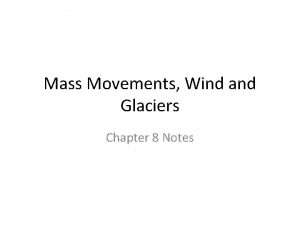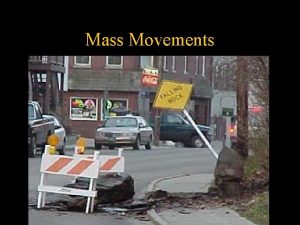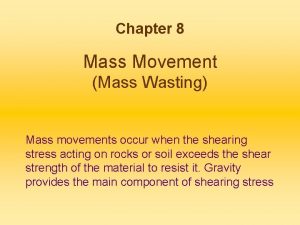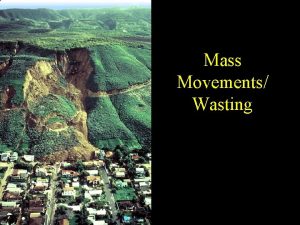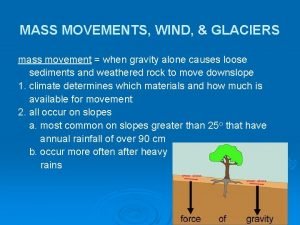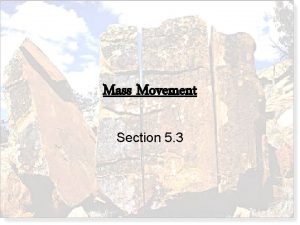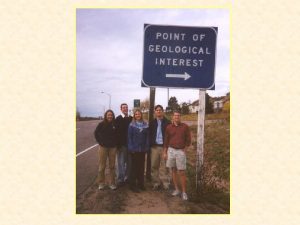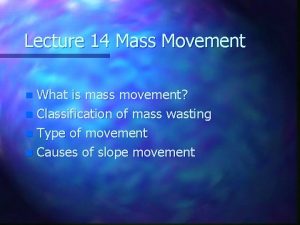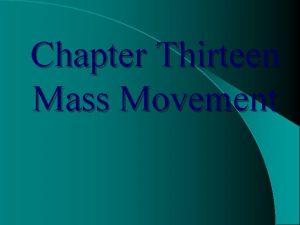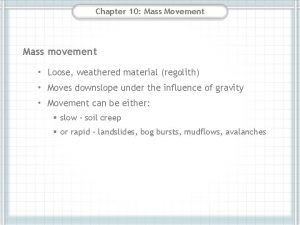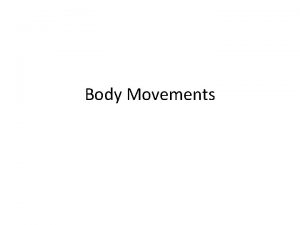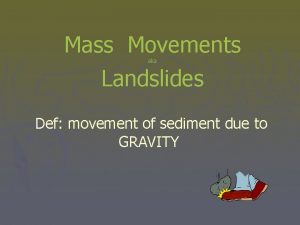Mass Movement Mass movements is the term used
























- Slides: 24

Mass Movement

‘Mass movements’ is the term used to define the different ways that weathered material can move downslope. The two forces acting on the material are; - 1. Gravity, which pulls the particles down. 2. Friction, which stops them sliding downhill too fast.

Four main factors influence mass movements; - 1. How much water is involved in the action. 2. How much of an angle is needed on the slope. 3. How quickly the movement happens. 4. The amount of vegetation cover is also important in some types of movement. 2

ROCKFALLS Answers are suggested on the following slides for you to check and amend your answers.

1. What angles are rockfalls most likely to happen at? 2. Which of the two forces is the dominant one? 3. Which secondary processes are very important too? 4. So what condition ought the rock face to be in if a rockfall is to happen? Four more questions after the answers to these!

1. The best angle is between 70 and 90 degrees from horizontal. 2. Gravity is more effective here than friction. 3. Freeze-thaw and frost-shattering are important processes. 4. The face should be welljointed or cracked for rockfalls to happen.

6. Explain what is meant by ‘sizesorting’ and why it happens. 5. What angle does scree usually initially settle at? 7. Why will weathering of the rock face cease in time? 8. What is the usual angle of an inactive scree slope?

6. Particles travel down the slope depending on their weight and density. Lighter ones finish nearer to the face, heavier ones travel further, often moved by rolling over smaller ones. 5. Scree settles between 34 and 40 degrees, usually. 7. If scree covers the rock face, freeze-thaw cannot act and weathering stops. 8. The inactive slope consolidates at 37 degrees where it usually grasses over.

Climbers call these types of screes ‘stone chutes’. Their technical name is talus slope.

A rockfall and talus slope in Arizona

LANDSLIDES/SLUMPS; - Answer the questions that follow, in sentences in your jotter. Answers are suggested on the following slides for you to check and amend your answers.

1. What two roles does heavy rainfall play? 2. Where can the slip plane/ glide plane be found? 4. Slumps- special kinds of slides- have a different kind of slip plane- in what way? 3. How does the result of this movement look different to a rockfall? 5. What is the difference in the motion of the material in slumps?

1. It lubricates the slip plane and makes the material heavier and likely to move. 2. The slip plane is below the surface. 4. A shear is curved, steeper at the top than the bottom. 3. There are ‘bald’ spots visible on the slip plane and there is no sorting. Material moves as a ‘unit’. (see p 88 fig 4. 14. B) 5. Slumped ground has rotated whereas slides travel down in a straight line.

The Quirang in Skye shows spectacular rotational slumping. (see p 89 fig 4. 15) Spot the tourists?

MUDFLOWS; Answer the questions that follow. Answers are suggested on the following slides for you to check and amend your answers.

1. How gentle a slope can mudflows start on? 2. What angles are more likely? 4. Describe the two factors that help create mudflows. 3. What shape does the material stop in? 5. How do you describe the speed of a mudflow? 6. What condition does the surface below the flow have to have?

1. They can start on a slope as gentle as 5 or 6 degrees. 2. Angles over 10 degrees are more common. 4. They need high rainfall and little vegetation cover. 3. The material stops in a lobe/fan shape. 5. Mudflows happen very quickly indeed! 6. The lower layers need to be impermeable to water.

This mudflow happened several years before the photo was taken- the scars are still very visible!

A mudflow in Central America, October 2005

SOIL CREEP; - read Answer the questions that follow Answers are suggested on the following slides for you to check and amend your answers.

1. What angle of slope does this require? 2. Define the term ‘heave’. 4. Describe how biological activity may enhance the activity. 3. Why do particles not travel back at the same angle as they heave? 5. Describe what terracettes look like. 6. Describe four results of soil creep.

1. Angles over 6 degrees are susceptible. 2. Heave is the upward motion of particles. 4. Plant roots and burrowing animals help the soil to move. 3. Gravity (and the effects of contraction) are the dominant forces here. 5. Terracettes are small-scale ridges parallel to the slope. 6. See the next slide for the answer.

6. a). Fence and telegraph posts lean down-slope as their supports are undermined by the creep. ( note these are the same effect) b). Soil piles up behind walls, creating deeper pockets, pushing walls over in time. ( note there are two effects here!) c). Roads may crack open parallel to the slope angle, and will need frequent repair. d). Terracettes spoil the smooth surface of fields, and affect land use.

Terracettes can be seen to the right of the river valley.
 What is
What is Chapter 8 mass movements wind and glaciers
Chapter 8 mass movements wind and glaciers What is a non movement area
What is a non movement area Short term planning and long term planning
Short term planning and long term planning In my understanding
In my understanding Long term memory vs short term memory
Long term memory vs short term memory Site:slidetodoc.com
Site:slidetodoc.com Short term and long term human resource planning
Short term and long term human resource planning Position-to-term rule
Position-to-term rule Difference between long term and short term liabilities
Difference between long term and short term liabilities Difference between long term and short term liabilities
Difference between long term and short term liabilities Expand a+bc'+abd'+abcd to minterms and maxterms
Expand a+bc'+abd'+abcd to minterms and maxterms Rules in finding the nth term
Rules in finding the nth term Term to term rule
Term to term rule Long-term goals
Long-term goals Short term finance planning
Short term finance planning D'arsonval meter movement used with full-wave rectification
D'arsonval meter movement used with full-wave rectification Hình ảnh bộ gõ cơ thể búng tay
Hình ảnh bộ gõ cơ thể búng tay Ng-html
Ng-html Bổ thể
Bổ thể Tỉ lệ cơ thể trẻ em
Tỉ lệ cơ thể trẻ em Voi kéo gỗ như thế nào
Voi kéo gỗ như thế nào Chụp tư thế worms-breton
Chụp tư thế worms-breton Hát lên người ơi alleluia
Hát lên người ơi alleluia Môn thể thao bắt đầu bằng chữ f
Môn thể thao bắt đầu bằng chữ f

